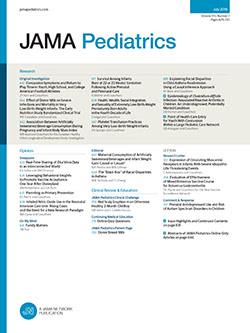使用 GLP1 受体激动剂治疗肥胖症青少年的自杀意念或自杀未遂风险
IF 24.7
1区 医学
Q1 PEDIATRICS
引用次数: 0
摘要
重要性胰高血糖素样肽 1 受体激动剂(GLP1R)越来越多地被用于治疗青少年肥胖症。目前尚不清楚 GLP1R 治疗是否与该人群中的自杀意念或自杀未遂有关。目的 研究肥胖症青少年中 GLP1R 启动与自杀意念或自杀未遂之间的关联。分析包括来自 120 家医疗机构的数据,主要来自美国。参与者为 12 至 18 岁的青少年,他们被诊断患有肥胖症,并有证据表明在接下来的一年内服用过抗肥胖 GLP1R 处方或接受过不含 GLP1R 的生活方式干预。主要结果和测量指标在12个月的随访期间,根据患者电子健康记录中记录的《国际疾病和相关健康问题统计分类第十版》代码,自杀意念或自杀未遂的发生率。上呼吸道感染(URTI)诊断结果作为阴性对照结果,胃肠道症状(GI)诊断结果作为阳性对照结果。结果 GLP1R队列中共有4052名青少年患有肥胖症并同时接受了抗肥胖干预,对照队列中共有50 112名青少年患有肥胖症并同时接受了抗肥胖干预。通过倾向得分匹配,每个平衡队列中均有 3456 名参与者。处方 GLP1R 与随访 12 个月期间自杀意念或自杀未遂风险降低 33% 相关(1.45% vs 2.26%;危险比 [HR],0.67;95% CI,0.47-0.95;P = .02),与胃肠道症状发生率升高相关(6.9% vs 5.4%;HR,1.41;95% CI,1.12-1.78;P = .结论和相关性在这项研究中,与未服用 GLP1R 并接受生活方式干预治疗的匹配患者相比,服用 GLP1R 的肥胖症青少年自杀意念或自杀未遂的发生率较低。这些结果表明,GLP1R 在青少年中具有良好的精神安全性。在服用了 GLP1R 的肥胖症青少年中,发现自杀意念的 HRs 有所降低,这为今后的研究提供了潜在的途径。本文章由计算机程序翻译,如有差异,请以英文原文为准。
Risk of Suicidal Ideation or Attempts in Adolescents With Obesity Treated With GLP1 Receptor Agonists
ImportanceGlucagon-like peptide 1 receptor agonists (GLP1R) are increasingly being used for the treatment of obesity in adolescents. It is currently unknown whether GLP1R treatment is associated with suicidal ideation or attempts in this population.ObjectiveTo investigate the association between GLP1R initiation and suicidal ideation or attempts in adolescents with obesity.Design, Setting, and ParticipantsRetrospective propensity score–matched cohort study using electronic health records from the TriNetX global federated network between December 2019 and June 2024. The analysis included data from 120 health care organizations, mainly from the USA. Participants were adolescents aged 12 to 18 years with a diagnosis of obesity and evidence of an antiobesity GLP1R prescription or lifestyle intervention without GLP1R within the following year. Cohorts were balanced for baseline demographic characteristics, psychiatric medications and comorbidities, and diagnoses associated with socioeconomic status and health care access using propensity score matching.ExposureInitial prescription of GLP1R (study cohort) or lifestyle intervention without GLP1R (control cohort).Main Outcomes and MeasuresIncidence of suicidal ideation or attempts based on International Statistical Classification of Diseases and Related Health Problems, Tenth Revision codes recorded in patient electronic health records during 12 months of follow-up. Diagnoses of upper respiratory tract infections (URTI) were used as negative control outcomes, and gastrointestinal symptoms (GI) were used as positive control outcomes.ResultsA total of 4052 adolescents with obesity and a concomitant antiobesity intervention were identified for the GLP1R cohort and 50 112 were identified for the control cohort. Propensity score matching resulted in 3456 participants in each balanced cohort. Prescription of GLP1R was associated with a 33% reduced risk for suicidal ideation or attempts over 12 months of follow-up (1.45% vs 2.26%; hazard ratio [HR], 0.67; 95% CI, 0.47-0.95; P = .02) and a higher rate of GI symptoms (6.9% vs 5.4%; HR, 1.41; 95% CI, 1.12-1.78; P = .003) but no difference in rates of URTI diagnoses.Conclusions and RelevanceIn this study, adolescents with obesity prescribed a GLP1R had a lower incidence of suicidal ideation or attempts compared with matched patients not prescribed GLP1R who were treated with lifestyle intervention. These results suggest a favorable psychiatric safety profile of GLP1R in adolescents. The detected reduction in HRs for suicidal ideation among adolescents with obesity prescribed GLP1R suggests potential avenues for future research.
求助全文
通过发布文献求助,成功后即可免费获取论文全文。
去求助
来源期刊

JAMA Pediatrics
PEDIATRICS-
CiteScore
31.60
自引率
1.90%
发文量
357
期刊介绍:
JAMA Pediatrics, the oldest continuously published pediatric journal in the US since 1911, is an international peer-reviewed publication and a part of the JAMA Network. Published weekly online and in 12 issues annually, it garners over 8.4 million article views and downloads yearly. All research articles become freely accessible online after 12 months without any author fees, and through the WHO's HINARI program, the online version is accessible to institutions in developing countries.
With a focus on advancing the health of infants, children, and adolescents, JAMA Pediatrics serves as a platform for discussing crucial issues and policies in child and adolescent health care. Leveraging the latest technology, it ensures timely access to information for its readers worldwide.
 求助内容:
求助内容: 应助结果提醒方式:
应助结果提醒方式:


